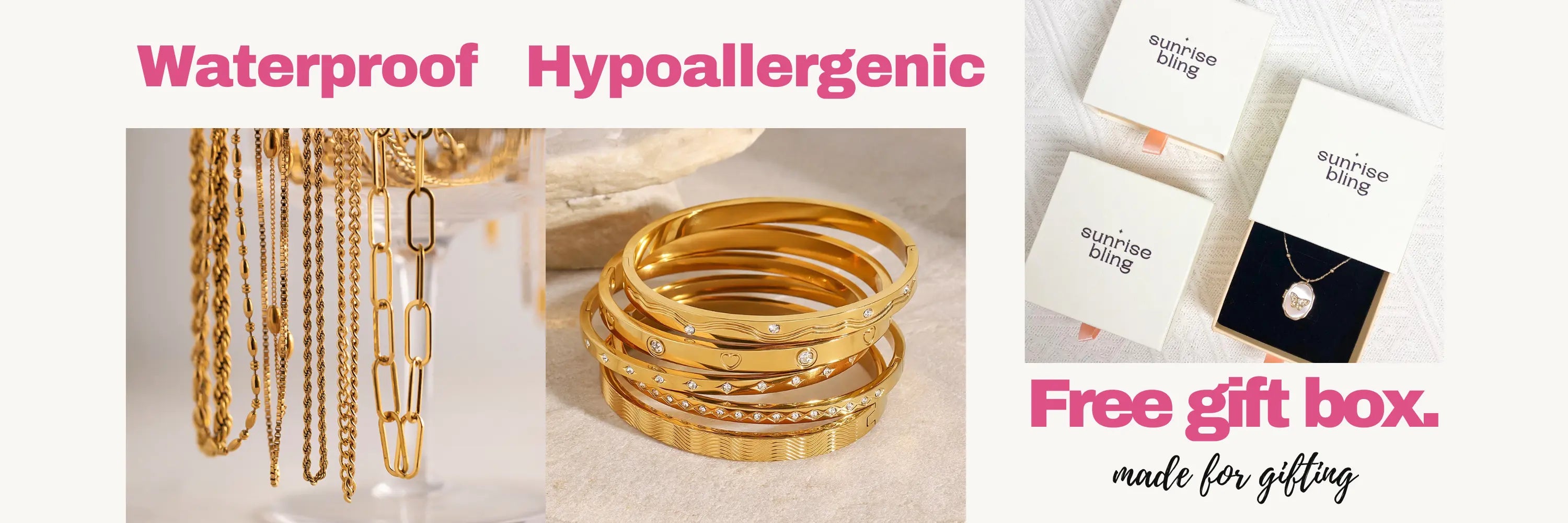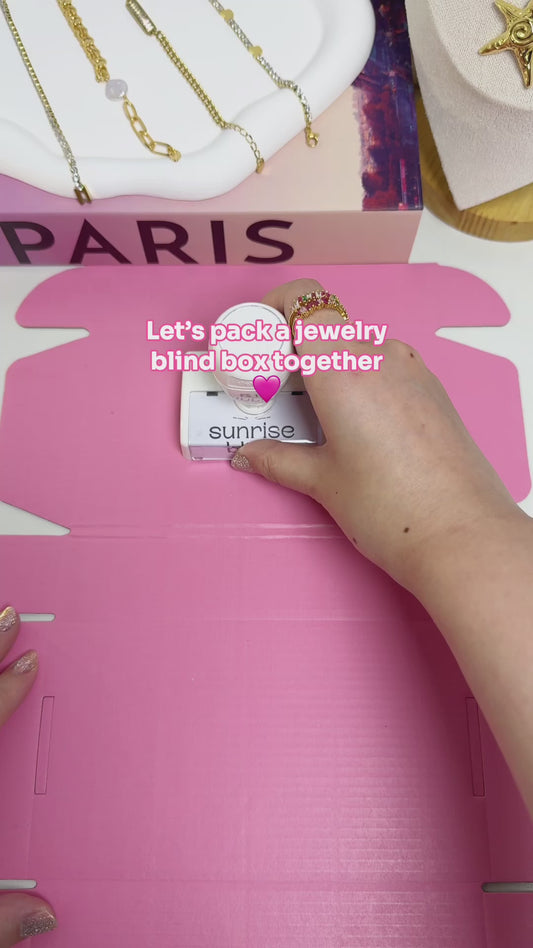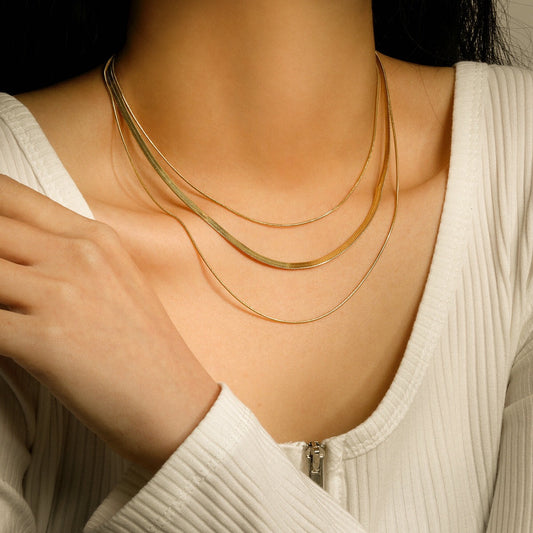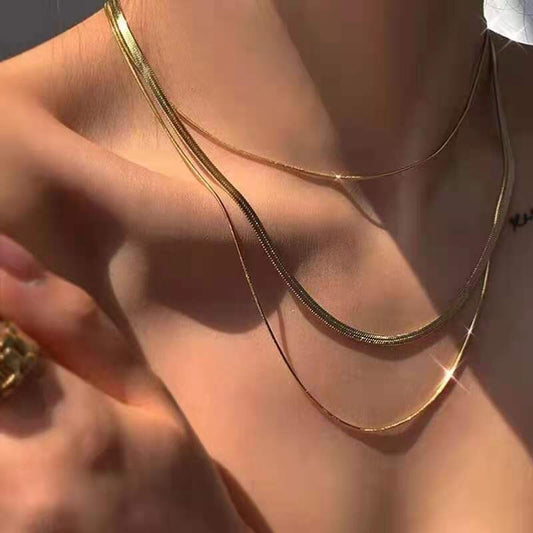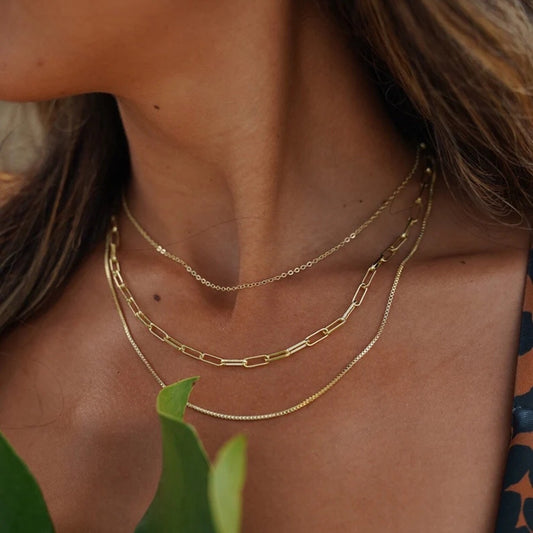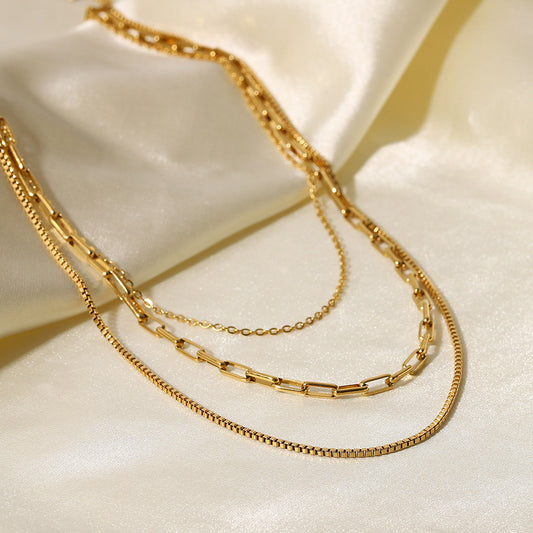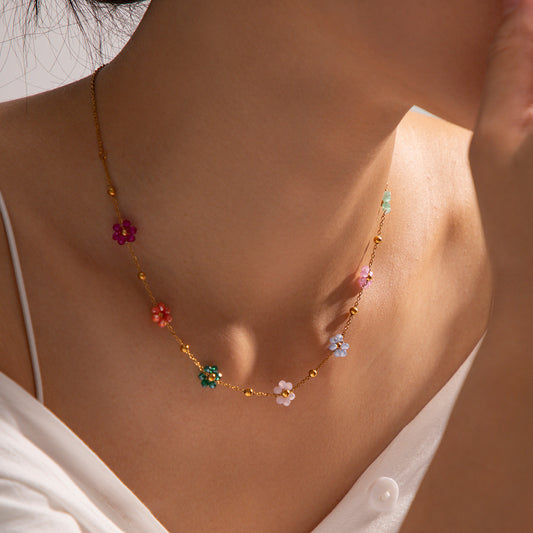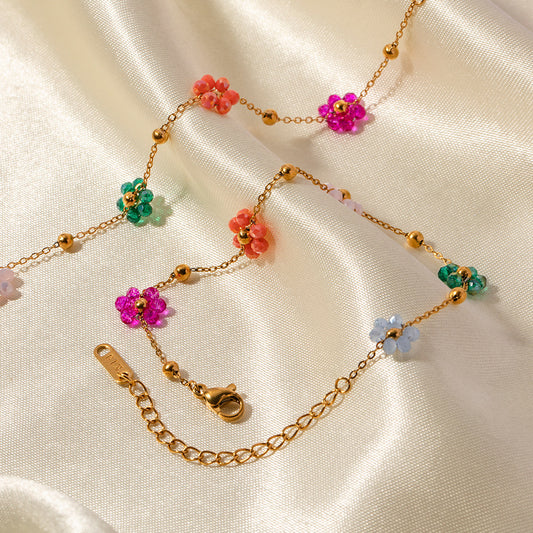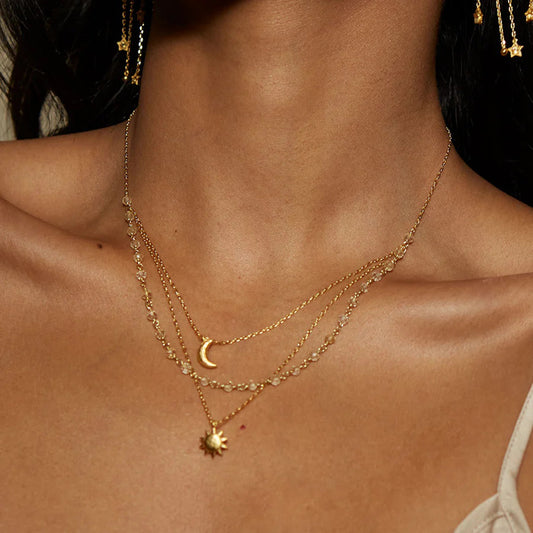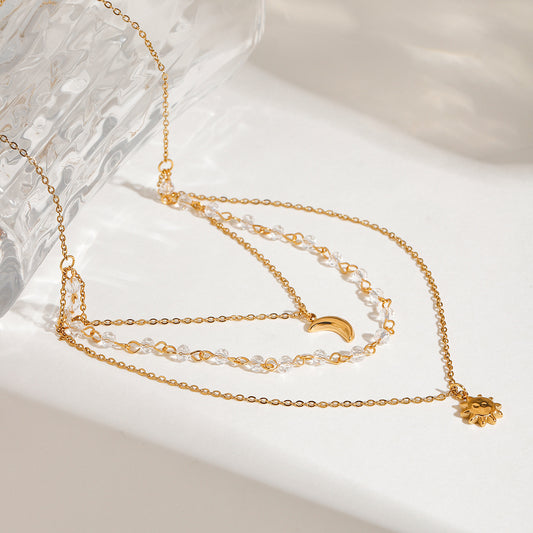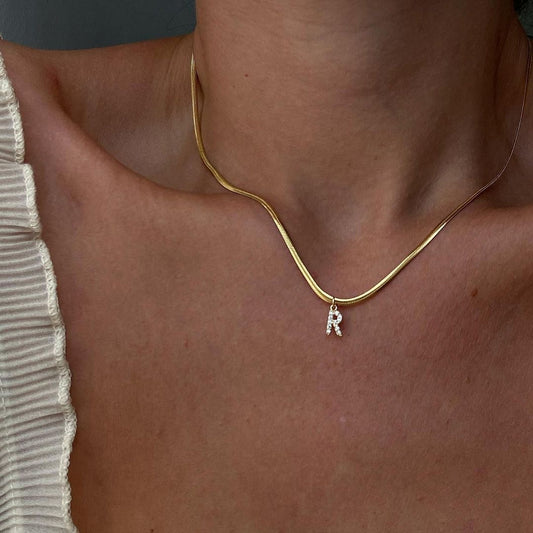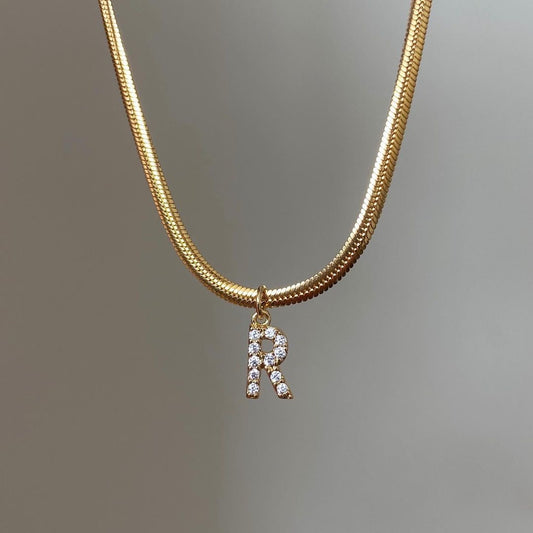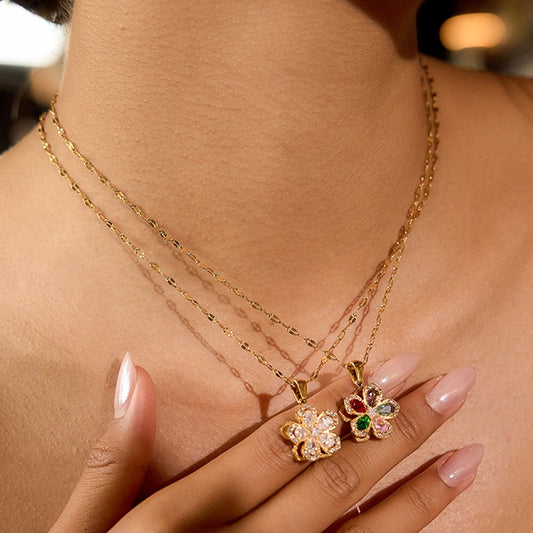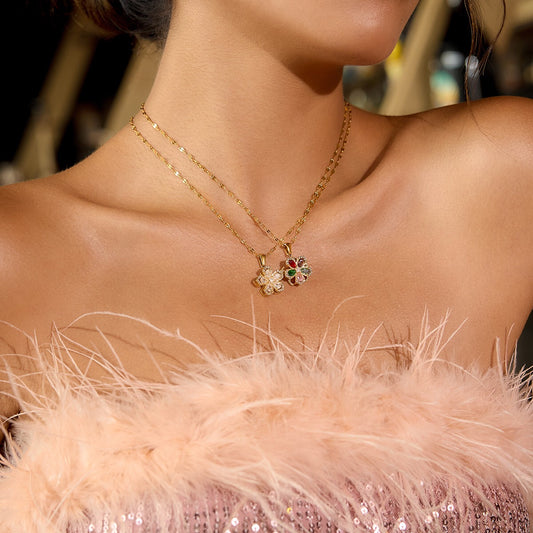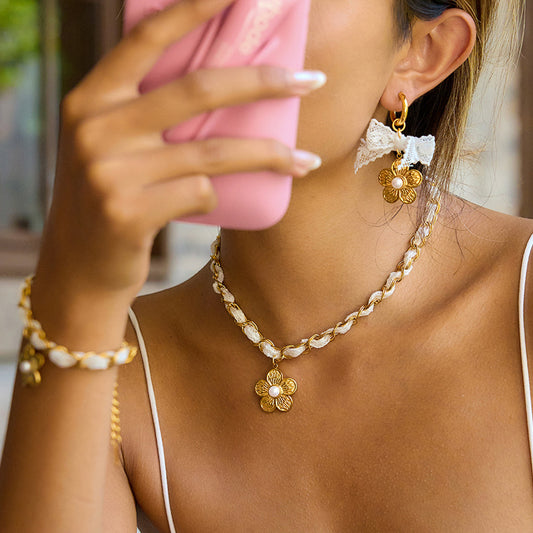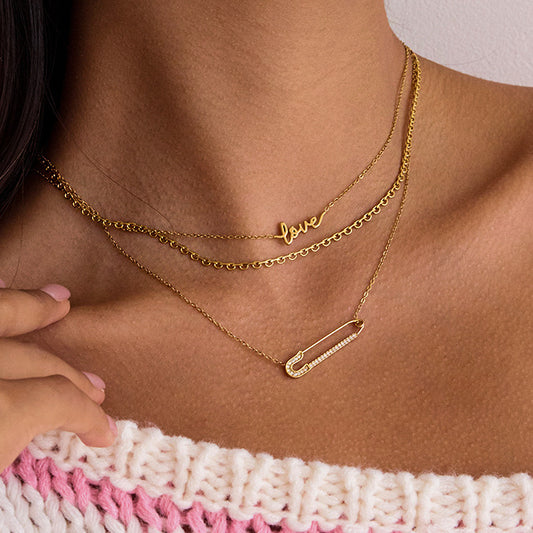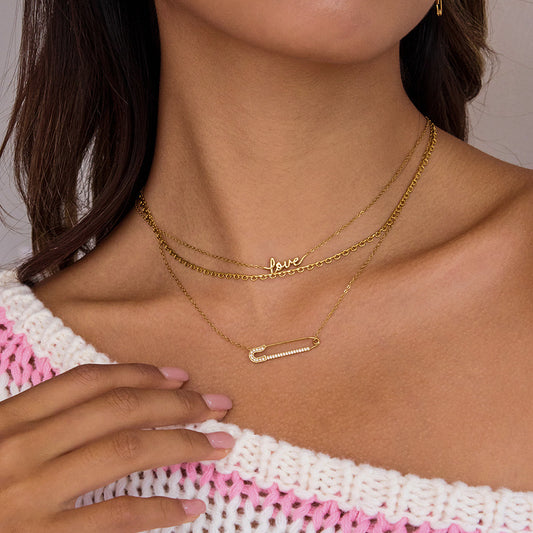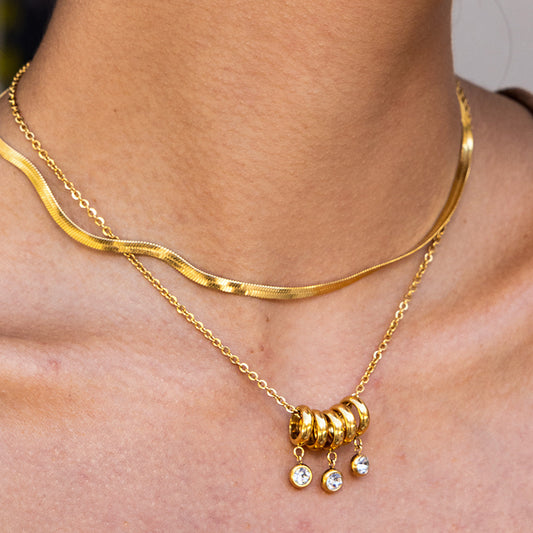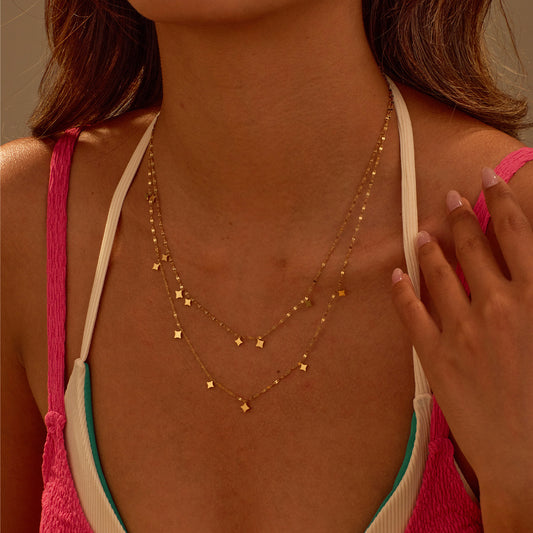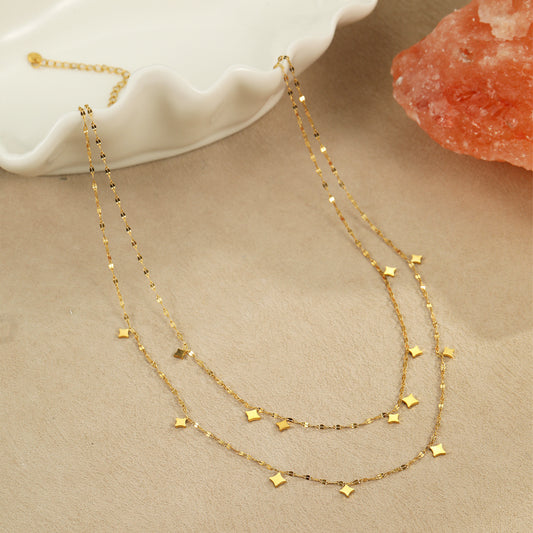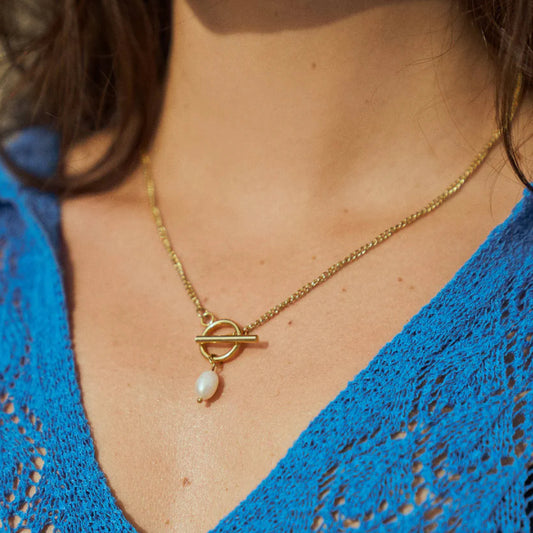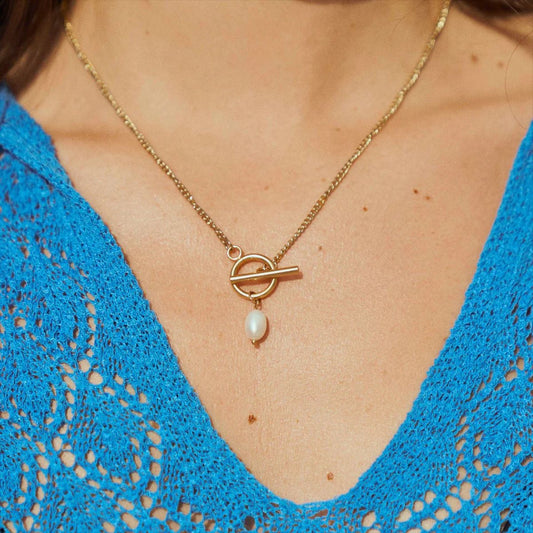Does sterling silver tarnish? The short answer is yes—but with the right quick fixes, you can keep your sterling silver jewelry bright and beautiful for years. The global sterling silver jewelry market is currently valued at approximately USD 12 billion and is expected to grow. This is a common frustration, but it’s avoidable: sterling silver’s tarnish is a natural reaction, not a sign of poor quality, and it can be reversed with simple, affordable fixes. Whether you own a sterling silver necklace, a pair of earrings, or a bracelet, understanding why tarnish happens and how to address it will help you get the most out of your jewelry. Let’s dive into the truth about sterling silver tarnish, plus actionable tips to keep your pieces looking their best.

Does Sterling Silver Tarnish?
The Short Answer: Yes—Here’s Why
Sterling silver does tarnish, and the science behind it is simple: sterling silver is an alloy of 92.5% pure silver and 7.5% other metals (usually copper). Pure silver alone is too soft for jewelry, so copper is added to make it durable—but copper reacts with oxygen, sulfur, and moisture in the air and on your skin to form a dark, dull layer called “tarnish” (chemically known as silver sulfide). This reaction isn’t a defect; it’s a natural property of the alloy.
What Tarnish Looks Like (and How to Spot It Early)
Tarnish typically appears as:
-
A faint yellow or brown tint on the surface of the jewelry (early stage).
-
A dark gray or black coating (advanced stage), especially in crevices (e.g., engraved details, chain links).
-
A dull, matte finish that replaces the metal’s original shine.
Spotting tarnish early (when it’s still light) makes cleaning easier—advanced tarnish may require more elbow grease, but it’s still reversible with the right quick fixes.

How Fast Does Sterling Silver Tarnish?
The speed of tarnishing depends on three key factors:
-
Environment: Humid climates (e.g., coastal areas) speed up tarnish—moisture in the air reacts with copper faster. Sulfur-rich environments (e.g., near factories, pools with chlorine) also accelerate tarnish.
-
Wear Frequency: Jewelry worn daily tarnishes slower—your skin’s natural oils create a thin barrier that protects the silver. Pieces stored for months (e.g., seasonal jewelry) tarnish faster due to prolonged exposure to air.
-
Care Routine: Jewelry cleaned regularly and stored properly tarnishes 50% slower than pieces left dirty or exposed to air.
What is Sterling Silver Jewelry
Definition and Core Composition
Sterling silver jewelry is crafted from “sterling silver” (also marked “925 silver”), an alloy defined by its purity: 92.5% pure silver and 7.5% alloy metals. The “925” stamp (found on the inside of rings, back of pendants, or clasps of chains) confirms its authenticity—it’s a universal standard for quality sterling silver.
Key Alloy Metals in Sterling Silver
The 7.5% non-silver metals are chosen for durability and to enhance the jewelry’s properties:
-
Copper: The most common alloy—adds strength to pure silver (which is too soft to hold shape) and gives sterling silver its warm, classic tone. However, copper is the main culprit behind tarnish (as explained earlier).
-
Zinc or Nickel: Sometimes added to reduce tarnish or adjust the metal’s color. Nickel-free sterling silver (using zinc instead) is available for those with sensitive skin, though it still tarnishes (just slightly slower than copper-heavy sterling silver).
-
Argentium Silver: A premium variant that replaces some copper with germanium—this alloy is 93.5% silver, more tarnish-resistant, and hypoallergenic. It’s pricier than standard sterling silver but requires less maintenance.

How Sterling Silver Differs from Other “Silver” Jewelry
It’s easy to confuse sterling silver with other silver-toned jewelry—here’s the key difference:
-
Sterling Silver (925): 92.5% pure silver—durable, retains value, and tarnishes naturally.
-
Silver-Plated Jewelry: A thin layer of silver (often less than 0.1 microns) over a base metal (e.g., brass, copper). Tarnishes quickly (6–12 months) because the silver layer wears off, revealing the base metal.
-
Fine Silver (999): 99.9% pure silver—too soft for jewelry (bends easily) and tarnishes faster than sterling silver due to the higher silver content. Rarely used for everyday jewelry.
Why is Sterling Silver Jewelry so popular
Affordable Luxury
Sterling silver jewelry offers “luxury on a budget”—it has the same elegant silver shine as more expensive metals (e.g., platinum, white gold) but costs a fraction of the price. For example, a sterling silver necklace typically costs \(30–\)150, while a comparable white gold necklace costs \(200–\)500+. This accessibility makes it a favorite for shoppers who want high-quality jewelry without overspending.
Timeless Style
Sterling silver’s cool, silvery tone never goes out of fashion. It complements every skin tone (warm, cool, neutral) and pairs with any outfit—from casual jeans and a tee to formal gowns. Unlike trendy metals (e.g., black-plated steel), sterling silver has been a jewelry staple for centuries and will remain stylish for years to come.
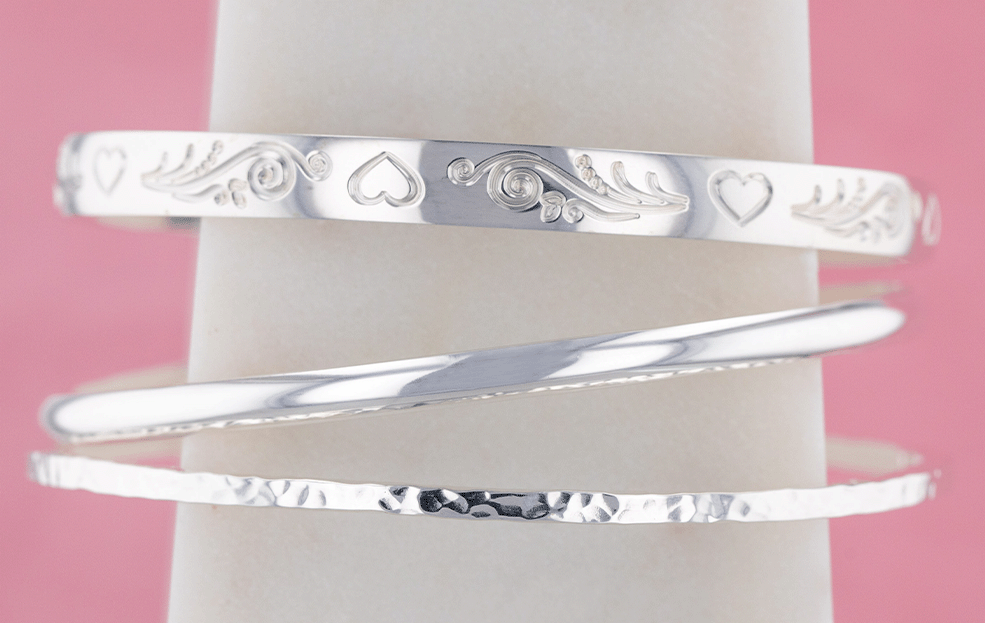
Versatility Across Occasions
Sterling silver jewelry adapts to every vibe:
-
Everyday Wear: A simple sterling silver band or pendant necklace adds subtle shine to casual looks.
-
Work/Professional: A pair of small sterling silver studs or a thin bracelet is office-appropriate—polished but not distracting.
-
Formal Events: A sterling silver necklace with gemstone accents (e.g., amethyst, turquoise) elevates evening wear without competing with the outfit.
Durability for Daily Use
Thanks to the copper alloy, sterling silver is tough enough for daily wear. Unlike fine silver (which bends easily) or silver-plated jewelry (which wears off), sterling silver can withstand minor scratches, typing, and everyday activities—making it ideal for pieces you wear regularly (e.g., wedding bands, daily necklaces).
Popular styles of Sterling Silver Jewelry
Minimalist Sterling Silver Jewelry
-
Slim Band Rings: Thin (2–3mm) sterling silver bands with a polished or brushed finish. Perfect for everyday wear or stacking with other rings. Some have subtle textures (e.g., hammered metal) for added depth.
-
Delicate Necklaces: Tiny pendants (e.g., initials, stars, hearts) on thin sterling silver chains (16–18 inches). Ideal for layering or wearing alone for a “less is more” look.
-
Small Stud Earrings: Simple sterling silver studs (round, square, or geometric shapes) —a wardrobe essential that works for work, school, or casual outings.
Statement Sterling Silver Jewelry
-
Chunky Bracelets: Thick sterling silver cuffs or link bracelets (8–10mm links) with bold designs (e.g., tribal patterns, engraved motifs). Adds edge to casual outfits (e.g., leather jackets, hoodies).
-
Gemstone-Accented Necklaces: Sterling silver pendants or chains with colorful gemstones (e.g., turquoise, coral, onyx). The silver’s cool tone makes the gemstones pop—perfect for adding color to neutral outfits.
-
Hoop Earrings: Large or medium-sized sterling silver hoops (1.5–3 inches) —timeless and versatile, pairing with everything from dresses to jeans.
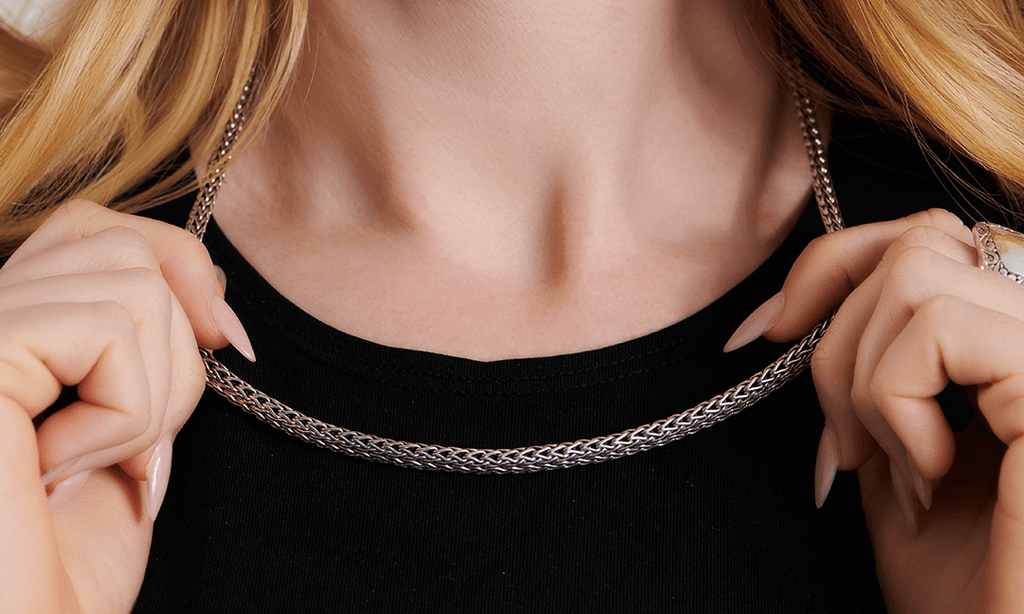
Vintage/Bohemian Sterling Silver Jewelry
-
Engraved Sterling Silver Pieces: Rings, bracelets, or necklaces with intricate engravings (e.g., floral patterns, quotes). Often has an antique finish (achieved via oxidation) for a retro vibe.
-
Beaded Sterling Silver Jewelry: Bracelets or necklaces with sterling silver beads mixed with natural materials (e.g., wood, stone). Popular for bohemian styles—great for music festivals or beach days.
-
Layered Sets: Matching sterling silver necklace and bracelet sets with dainty chains and small charms (e.g., feathers, moons). Designed to be worn together for a cohesive, boho look.
How to wear Sterling Silver Jewelry
Pairing with Outfits (By Occasion)
-
Everyday Casual:
-
Outfit: High-waisted blue jeans, a white graphic tee, and white sneakers.
-
Jewelry: A slim sterling silver band (worn alone) and a delicate initial necklace (16-inch chain). The subtle shine adds polish without overcomplicating the look.
-
Work/Professional:
-
Outfit: A navy blazer, white silk blouse, and tailored black pants.
-
Jewelry: Small sterling silver studs and a thin bracelet (3mm link). The understated pieces keep the focus on work while adding a touch of elegance.
-
Date Night:
-
Outfit: A little black dress and strappy heels.
-
Jewelry: A gemstone-accented sterling silver necklace (e.g., a small amethyst pendant) and medium-sized hoop earrings. The gemstone adds color, while the silver complements the dress.
-
Beach/Vacation:
-
Outfit: A floral swimsuit, linen cover-up, and flip-flops.
-
Jewelry: A beaded sterling silver bracelet and a layered necklace set. The pieces are lightweight and water-resistant (with quick post-beach cleaning).
Styling Tips for Maximum Shine
-
Mix with Other Metals (Carefully): Sterling silver pairs beautifully with gold or rose gold—e.g., stack a sterling silver band with a thin gold band for a two-tone look. Stick to 2–3 metals max to avoid clutter.
-
Highlight the Silver’s Cool Tone: Pair sterling silver with cool-colored outfits (e.g., navy, gray, mint) to make the metal’s shine pop. Warm colors (e.g., orange, terracotta) also work—they create a striking contrast.
-
Avoid Covering Tarnished Areas: If a piece has light tarnish, wear it in a spot that’s visible (e.g., a necklace instead of a bracelet hidden by sleeves) —this reminds you to clean it later, and light tarnish is less noticeable than you think.
Sterling Silver Jewelry: perfect gift for your wife
Affordable Yet Meaningful
Sterling silver jewelry is a perfect gift for your wife because it balances affordability with sentiment. Unlike expensive metals (e.g., platinum), you can give her a high-quality piece (e.g., a personalized necklace, a gemstone ring) without breaking the bank. She’ll appreciate that you chose something durable (she can wear it daily) and stylish (it fits her wardrobe).
Fits Her Unique Style
With so many sterling silver styles, you can find a piece that matches her aesthetic—proving you pay attention to her taste:
-
Minimalist Wife: A delicate sterling silver pendant necklace (e.g., a tiny heart or her initial).
-
Glamorous Wife: A gemstone-accented sterling silver bracelet (e.g., turquoise or diamond accents).
-
Bohemian Wife: A beaded sterling silver necklace or an engraved cuff bracelet.
-
Sentimental Wife: A personalized sterling silver ring (engraved with your wedding date or children’s initials).
Durable Enough for Her Daily Routine
Your wife can wear sterling silver jewelry every day—whether she’s a teacher, a nurse, a mom, or a professional—without worrying about damage. Unlike delicate jewelry (e.g., pearl earrings), sterling silver is scratch-resistant and can handle busy schedules. With quick weekly cleaning (per the “How to clean” section), it will stay bright for years.
Symbolizes Lasting Love
Sterling silver’s durability mirrors the strength of your marriage—it’s a tangible reminder of your lasting love. Many couples choose sterling silver wedding bands or anniversary gifts because the metal ages gracefully (like a long-term relationship) and can be passed down as a family heirloom.
How to clean Sterling Silver Jewelry
Quick Fixes for Light Tarnish (5–10 Minutes)
For early-stage tarnish (faint yellow/brown tint), these quick fixes restore shine in minutes:
-
Baking Soda + Water Paste: Mix 2 parts baking soda with 1 part water to make a thick paste. Apply a small amount to the jewelry with a soft cloth, gently rub in circular motions, then rinse with warm water and dry. This works for most sterling silver pieces (avoid gemstones—baking soda can scratch them).
-
White Vinegar + Baking Soda Soak: Fill a bowl with 1 cup white vinegar and 2 tablespoons baking soda (it will fizz). Submerge the jewelry for 2–3 minutes, then rinse and dry. This is ideal for chain necklaces or bracelets with lots of links.
-
Commercial Silver Polish Cloth: Use a pre-treated silver polish cloth (e.g., Wright’s Silver Cream Cloth) to buff the jewelry. These cloths have mild abrasives that lift tarnish without scratching—perfect for on-the-go touch-ups.
Deep Cleaning for Advanced Tarnish (15–20 Minutes)
For dark gray/black tarnish, use this more thorough method:
-
Aluminum Foil + Salt + Baking Soda Bath: Line a bowl with aluminum foil (shiny side up). Add 1 cup hot water, 1 tablespoon salt, and 1 tablespoon baking soda. Stir until dissolved. Submerge the jewelry and let it soak for 10–15 minutes (the aluminum reacts with the tarnish, pulling it off the silver). Remove, rinse, and dry—your jewelry will look like new!
-
Note: Do not use this method for sterling silver with gemstones (e.g., turquoise, pearls) or enamel— the solution can damage delicate materials.
Cleaning Sterling Silver with Gemstones
For gemstone-accented sterling silver, use a gentle approach to avoid damaging the stones:
-
Mild Soap + Warm Water: Mix 1 drop of mild dish soap with 1 cup warm water. Dip a soft-bristled toothbrush (unused) into the soapy water and gently scrub the silver areas (avoid the gemstones). Rinse with warm water and dry immediately with a lint-free cloth.
-
Gemstone-Specific Cleaners: For hard gems (e.g., diamonds, sapphires), use a jewelry cleaner designed for gemstones (e.g., Connoisseurs Diamond Cleaner). Follow the instructions carefully—never soak porous gems (e.g., opals, emeralds).
Does 925 sterling silver tarnish
The Answer: Yes—925 Sterling Silver Tarnishes (Here’s Why)
925 sterling silver (the standard for sterling silver jewelry) does tarnish—and for the same reason as all sterling silver: it contains 7.5% copper. The “925” stamp refers to the silver purity (92.5% pure silver), not resistance to tarnish. In fact, 925 sterling silver tarnishes at the same rate as other sterling silver alloys— the copper content is the main factor, not the purity.
How to Keep 925 Sterling Silver Bright
The quick fixes for 925 sterling silver are the same as for any sterling silver:
-
Clean it weekly with a baking soda paste or silver polish cloth.
-
Store it in an airtight pouch or anti-tarnish jewelry box (add a silica gel packet to absorb moisture).
-
Wear it daily—skin oils slow down tarnish.
Myth Busting: “925 Silver Doesn’t Tarnish”
A common myth is that 925 silver is “tarnish-proof”—this is false. All sterling silver (including 925) contains copper, so it will tarnish over time. The myth likely comes from confusion with stainless steel (which doesn’t tarnish) or argentium silver (which tarnishes slower). If a seller claims their 925 silver is “tarnish-proof,” it’s a red flag—they may be selling silver-plated jewelry instead.
Does gold plated sterling silver tarnish
The Answer: Yes—Gold Plated Sterling Silver Tarnishes (But Differently)
Gold plated sterling silver does tarnish, but the process is different from pure sterling silver:
-
How It Tarnishes: The gold plating (a thin layer of gold over sterling silver) wears off over time (6–12 months with daily wear), revealing the underlying sterling silver. Once the silver is exposed, it tarnishes just like regular sterling silver—forming a dark layer on the exposed areas.
-
Signs of Tarnish: You’ll notice dark spots or edges where the gold plating has worn thin (e.g., the inside of rings, the links of chains that rub together).
How to Slow Tarnish on Gold Plated Sterling Silver
Since the gold plating is thin, it requires extra care to delay tarnish:
-
Avoid Harsh Chemicals: Remove the jewelry before applying perfume, lotion, or hand sanitizer—chemicals break down the gold plating faster.
-
Minimize Rubbing: Gold plating wears off where the jewelry rubs against skin or clothing (e.g., bracelet links, ring bands). Choose styles with smooth, low-profile designs to reduce friction.
-
Clean Gently: Wipe the jewelry with a dry, soft cloth after wear—avoid soap or water (which can speed up plating wear). If it gets dirty, use a damp cloth and dry immediately.
When to Re-Plate Gold Plated Sterling Silver
Once the gold plating wears off and the silver starts to tarnish, you can have the piece re-plated by a jeweler. Re-plating costs $3 0–\(80 per piece, depending on the size and complexity (e.g., a small pendant costs \)30–\(50, while a large bracelet costs \)60–$80). Re-plating restores the gold finish, making the jewelry look new again—and extends its life by 6–12 months of additional wear.
Does zales sterling silver tarnish
The Answer: Yes—Zales Sterling Silver Tarnishes (But It’s Quality-Made)
Zales sterling silver jewelry does tarnish—because, like all sterling silver, it’s made of 92.5% pure silver and 7.5% copper alloy. Zales is a reputable jewelry retailer, but their sterling silver isn’t “tarnish-proof”—no sterling silver is. However, Zales’ sterling silver pieces are crafted to high standards, which can slow down tarnishing slightly:
-
Alloy Quality: Zales uses high-purity copper in their sterling silver, which reduces the risk of uneven tarnish (e.g., splotchy dark spots) compared to lower-quality sterling silver.
-
Finishes: Many Zales sterling silver pieces have a polished or brushed finish that creates a protective barrier, delaying the start of tarnish by 2–3 months compared to unpolished sterling silver.
How to Care for Zales Sterling Silver to Prevent Tarnish
Zales even includes care instructions with their sterling silver jewelry, but these quick fixes will keep it bright longer:
-
Use Zales’ Recommended Cleaners: Zales sells a “Sterling Silver Cleaning Cloth” (specifically designed for their pieces) that’s gentle on finishes and effective at lifting light tarnish. It’s available in-store or online for \(5–\)10.
-
Store in Zales’ Anti-Tarnish Packaging: Many Zales sterling silver pieces come in anti-tarnish pouches (lined with a special fabric that absorbs sulfur and moisture). Reuse these pouches—they’re more effective than generic jewelry boxes at preventing tarnish.
-
Follow Zales’ Wear Guidelines: Zales recommends removing their sterling silver jewelry before swimming, showering, or applying beauty products—this aligns with our earlier tips and will significantly reduce tarnish.
What to Do If Zales Sterling Silver Tarnishes
If your Zales sterling silver piece does tarnish, don’t panic—use the same methods as regular sterling silver:
-
For light tarnish: Use the Zales cleaning cloth or a baking soda paste (avoid abrasive cleaners that could scratch Zales’ polished finishes).
-
For advanced tarnish: Use the aluminum foil + salt + baking soda bath (only for solid Zales sterling silver—skip this for pieces with gemstones or enamel, which Zales warns against soaking).
-
For Gemstone-Accented Zales Pieces: Zales often sells sterling silver jewelry with cubic zirconia (CZ) or birthstones. Clean these with mild soap and water only—never use the aluminum method, as it can damage CZ settings.
Frequently asked questions about Sterling Silver Jewelry
Can I wear sterling silver jewelry in the shower?
No—you should remove sterling silver jewelry before showering. Here’s why:
-
Water + Soap Buildup: Shower water and soap leave a film on sterling silver that traps sulfur and moisture, accelerating tarnish. Over time, this film can make tarnish harder to remove.
-
Chlorine/Harsh Chemicals: If your shower has chlorinated water (common in apartments), chlorine reacts with copper in sterling silver to form a greenish tarnish that’s difficult to reverse.
-
Gemstone Damage: If your sterling silver has gemstones (e.g., Zales CZ pieces), water can seep into settings and loosen the stones—Zales explicitly warns against this.
The exception: If you forget and take a 2-minute cold shower with mild soap, rinse the jewelry immediately and dry it thoroughly—this won’t cause permanent damage. But regular shower wear will lead to frequent tarnish.
Is sterling silver jewelry hypoallergenic?
Mostly—but it depends on the alloy:
-
Standard Sterling Silver (with Copper): Copper is rarely an allergen—only 3–5% of people with sensitive skin react to it. If you do, you may notice mild redness or itching.
-
Nickel-Free Sterling Silver: Some brands (including Zales) offer nickel-free sterling silver (using zinc instead of nickel). This is 100% hypoallergenic and safe for people with nickel allergies (the most common jewelry allergy).
-
Argentium Silver: This premium sterling silver (with germanium) is also hypoallergenic—great for those with extremely sensitive skin, though it’s pricier than standard sterling silver.
To test: If shopping in-store, wear the piece for 15 minutes. If online, choose brands with “hypoallergenic” labels and free returns (in case of irritation).
How long does sterling silver jewelry last?
With proper care, sterling silver jewelry can last 20–30 years or more—many people pass it down as heirlooms. Key factors that affect lifespan:
-
Care Routine: Jewelry cleaned weekly and stored in anti-tarnish packaging lasts 2–3x longer than neglected sterling silver.
-
Wear Frequency: Pieces worn daily (with care) last longer than stored pieces—skin oils protect against tarnish, and regular use prevents the metal from becoming brittle.
-
Quality: High-quality sterling silver (e.g., Zales, Tiffany & Co.) lasts longer than cheap sterling silver (which may have impure copper that causes premature wear).
Even if a piece tarnishes heavily, it can almost always be restored with deep cleaning—sterling silver rarely “wears out” unless it’s bent or broken.
Can sterling silver jewelry be repaired if it breaks?
Yes—most sterling silver repairs are quick and affordable:
-
Broken Chains: Jewelers can solder broken links back together for \(15–\)40 (depending on chain thickness). For delicate Zales chains, ask for “micro-soldering” to avoid visible seams.
-
Loose Gemstones: If a CZ or birthstone falls out of a sterling silver setting (common in Zales pieces), jewelers can re-set it for \(20–\)50. Zales even offers a “Lifetime Warranty” on some gemstone settings—check your receipt for details.
-
Bent Rings/Bracelets: Solid sterling silver (e.g., Zales bands) can be reshaped by a jeweler for \(10–\)30. Avoid bending it yourself—sterling silver can crack if forced.
Does sterling silver jewelry hold its value?
Sterling silver holds its value better than silver-plated jewelry, but it’s not a “financial investment” like gold or platinum. Here’s what to expect:
-
Intrinsic Value: Sterling silver has a “melt value” (based on the current price of silver). As of 2024, silver is \(25–\)30 per ounce, so a 10-gram sterling silver necklace has a melt value of \(8–\)10.
-
Retail Value: When selling used sterling silver jewelry, you’ll get 30–50% of the original retail price (e.g., a \(100 Zales necklace sells for \)30–$50). Designer sterling silver (e.g., Tiffany) holds more value—up to 60% of retail.
-
Heirloom Value: If the piece has sentimental value (e.g., a Zales anniversary gift), its worth is priceless—many people keep sterling silver jewelry for decades for this reason, not financial gain.
Conclusion: Does Sterling Silver Tarnish? Quick Fixes to Keep It Bright
The answer to “Does sterling silver tarnish?” is clear: yes—but with the quick fixes we’ve shared, you can keep your sterling silver jewelry bright, durable, and stylish for years. From understanding why tarnish happens (thanks to copper in the alloy) to caring for Zales sterling silver or gold-plated pieces, the key is consistency: clean regularly, store properly, and wear mindfully.
Sterling silver jewelry’s appeal lies in its affordability, timeless style, and versatility—whether you’re gifting a Zales sterling silver necklace to your wife or wearing a minimalist band daily, it’s a piece that adapts to your life. And when tarnish does happen, it’s not a problem—it’s a chance to restore your jewelry to its original shine with simple, household ingredients.
Ready to give your sterling silver jewelry the care it deserves? Start with these quick steps: Grab a baking soda paste and a soft cloth to lift light tarnish, or order Zales’ cleaning cloth for your Zales pieces. For anti-tarnish storage, reuse jewelry pouches or invest in an anti-tarnish jewelry box (available for \(15–\)30 online). And if you’re shopping for new sterling silver—whether it’s a Zales design or a vintage find—look for the “925” stamp to ensure quality.
With these fixes, your sterling silver jewelry will keep shining bright—no more hiding tarnished pieces in your jewelry box. Enjoy the beauty of this timeless metal, knowing you have the tools to keep it looking its best.


